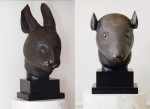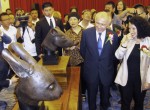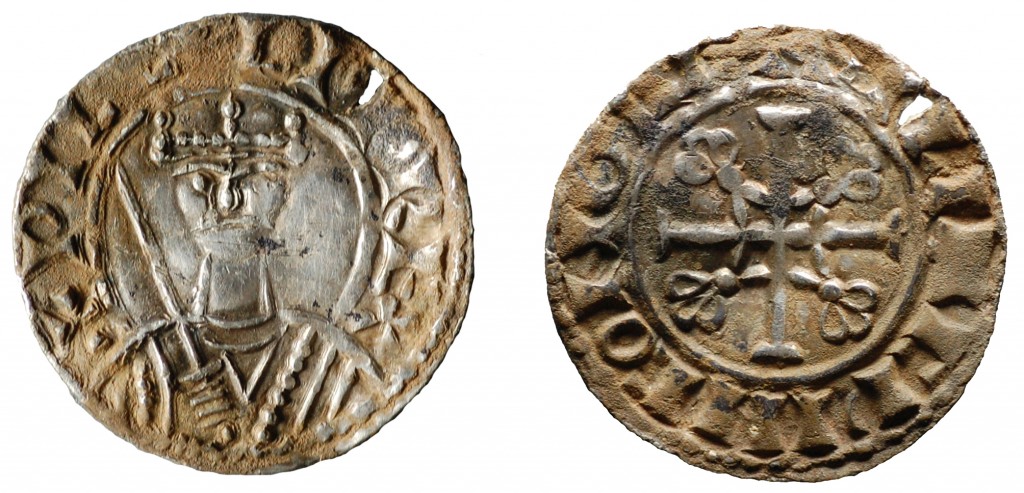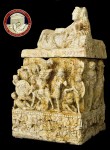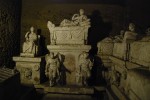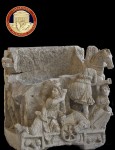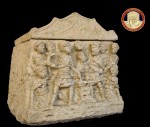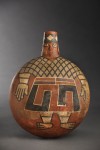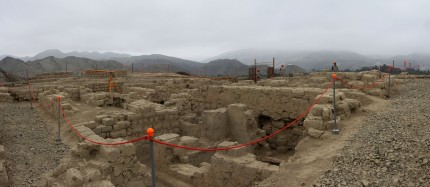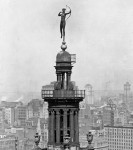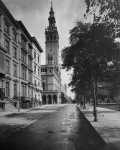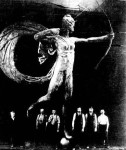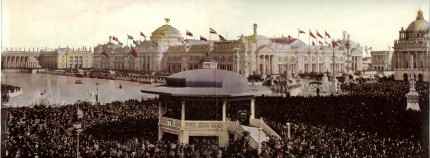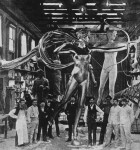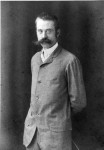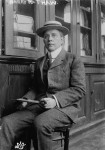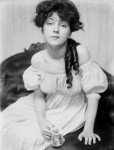Spurred by the horrors of the Sack of Rome, in 1527 Florentines revolted against their Medici rulers and established a self-governing Republic. Even as a Republic Florence maintained the pre-existing Medici alliance with France, Venice and Pope Clement VII (born Giulio di Giuliano de’ Medici) against the Imperial forces of Charles V. The League of Cognac, as the alliance was named, survived another two years until Pope Clement and the Republic of Venice signed the Treaty of Barcelona in June of 1529. Francis I of France wasn’t far behind. He signed the Treaty of Cambrai (aka, the Peace of the Ladies because both sides were represented by women in the negotiations, Francis by his mother Louise of Savoy and Charles by his aunt Margaret of Austria) in August of 1529.
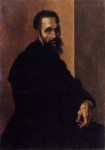 That left Florence the sole power in Italy fighting the combined armies of Spain and the Holy Roman Empire. On October 24th, 1529, Imperial troops laid siege to the city of Florence. The city was not caught unprepared. There had been rumblings since before the treaties that Pope Clement was willing to partner with Charles V if he could get Florence back for his family. The city government decided to implement defense plans from the 1526 Medici administration and created a committee, the Nine of the Militias, to work on city fortifications. Michelangelo Buonarroti was one of the Nine and was soon appointed “governor and general prosecutor of fortifications.”
That left Florence the sole power in Italy fighting the combined armies of Spain and the Holy Roman Empire. On October 24th, 1529, Imperial troops laid siege to the city of Florence. The city was not caught unprepared. There had been rumblings since before the treaties that Pope Clement was willing to partner with Charles V if he could get Florence back for his family. The city government decided to implement defense plans from the 1526 Medici administration and created a committee, the Nine of the Militias, to work on city fortifications. Michelangelo Buonarroti was one of the Nine and was soon appointed “governor and general prosecutor of fortifications.”
His military plans were ambitious, to put it mildly. Michelangelo’s architectural endeavors had a tendency towards grandiose vision which inevitably failed to come to fruition when the money dried up and technological obstacles could not be overcome. Only a few scattered pieces of his large, complex designs were ever built, and none of them have survived. There’s a beautiful design of his fortifications for the Porta al Prato di Ognissanti, one of the city gates, in the permanent collection of Florence’s Casa Buonarroti museum which was until yesterday on display at the Boston Museum of Fine Arts.
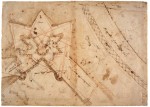 That’s not to say Michelangelo was paralyzed by his own ambition. He set to work on smaller, more practical tasks like adding observation bastions to all the gates and strengthening the city walls with embankments. He managed to measurably improve Florence’s defenses, particularly the strategically important bell tower and hill of San Miniato, despite his own forays into the implausible and the constant interference of his enemies in government. Perhaps the government’s biggest mistake was to appoint Malatesta Baglioni chief commander of Florence’s military. Michelangelo questioned his fidelity, having seen first hand his lazy, desultory efforts in the reinforcement of the city.
That’s not to say Michelangelo was paralyzed by his own ambition. He set to work on smaller, more practical tasks like adding observation bastions to all the gates and strengthening the city walls with embankments. He managed to measurably improve Florence’s defenses, particularly the strategically important bell tower and hill of San Miniato, despite his own forays into the implausible and the constant interference of his enemies in government. Perhaps the government’s biggest mistake was to appoint Malatesta Baglioni chief commander of Florence’s military. Michelangelo questioned his fidelity, having seen first hand his lazy, desultory efforts in the reinforcement of the city.
Michelangelo was right. Baglioni was a traitor from minute one, surrendering Perugia right off the bat without even an attempt at defense. Michelangelo tried to alert the government that Baglioni could not be trusted, but they blew him off. On September 21st, 1529, Michelangelo fled Florence for Venice, his ultimate destination France. The Florentine government declared him an outlaw and confiscated his property, but promised they’d let him off the hook if he came back. He returned on November 20th, just under one month into the siege.
The siege of Florence lasted ten long months. Florence’s military, led by great warrior and national hero Francesco Ferruccio, fought an impressively good fight against Imperial might, but he was broken in the end by a debilitating fever that interrupted his surprise attack, by the short-sightedness and petty conflicts of Florentine government, and by the traitor Malatesta Baglioni who kept the city militia from reinforcing Ferruccio’s men at a key moment. On August 10th, 1530, Florence surrendered.
 Despite political protections included in the articles of surrender, the Pope immediately got to work arresting and prosecuting Republican patriots. In just one day in October, five anti-Medici citizens were tortured and decapitated. Finally Charles V had to intervene to stop the papal bloodbath. Alessandro de’ Medici, ostensibly the son of Lorenzo II de’ Medici but widely thought to have been the illegitimate son of Pope Clement VII himself, was installed as ruler of Florence.
Despite political protections included in the articles of surrender, the Pope immediately got to work arresting and prosecuting Republican patriots. In just one day in October, five anti-Medici citizens were tortured and decapitated. Finally Charles V had to intervene to stop the papal bloodbath. Alessandro de’ Medici, ostensibly the son of Lorenzo II de’ Medici but widely thought to have been the illegitimate son of Pope Clement VII himself, was installed as ruler of Florence.
Michelangelo had good reason to fear for his own life in this atmosphere. He had opposed the Medici, was one of the Nine, had actively fought against the winning side, and there were false rumors that he had proposed to destroy the Medici palace in which his beloved patron Lorenzo the Magnificent had once entertained him and build in its place the Piazza of the Mules, named after the preponderance of bastards in the Medici line. So he went into hiding for three months.
It was some good hiding, too. For centuries nobody knew where he had gone. Contemporary biographers like artist Ascanio Condivi and historian Benedetto Varchi said he hid in the house of a friend. Michelangelo’s great-grandnephew Filippo Buonarroti thought he had squirreled himself away in the bell tower of San Nicolo’ church. Michelangelo left his mysterious spiderhole in November after the Pope’s retribution fury abated and he let it be known that he would pardon the artist if he would go back to working on the Medici tombs in the New Sacristy of the basilica of San Lorenzo.
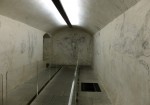 The kicker is Michelangelo only had to walk up a few steps to go from his well-concealed hiding place to resuming his work on the statuary of the Medici Chapel. For those three months, Michelangelo had hidden in a small corridor underneath the New Sacristy. A cramped space just 23 feet long and 6.5 feet wide, this unknown room, which he had doubtless encountered during his earlier work on the Medici tombs, was his solitary confinement prison for three months.
The kicker is Michelangelo only had to walk up a few steps to go from his well-concealed hiding place to resuming his work on the statuary of the Medici Chapel. For those three months, Michelangelo had hidden in a small corridor underneath the New Sacristy. A cramped space just 23 feet long and 6.5 feet wide, this unknown room, which he had doubtless encountered during his earlier work on the Medici tombs, was his solitary confinement prison for three months.
It’s a testament to what a great hidey-hole it was that the corridor wasn’t discovered until 1975 when structural work was being done underneath the Medici Chapel. How did they know it was his 1530 hiding place? Well, what’s a man like Michelangelo to do with nothing but four blank walls to stare at for three months? Make them not blank, of course.
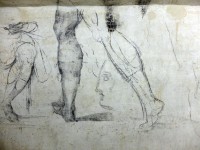
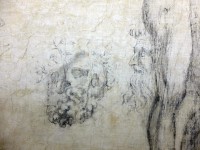
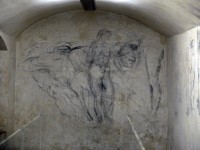
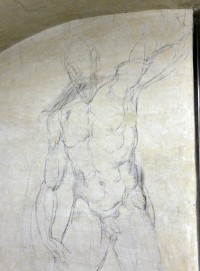
This incredible testimony of a scary, dangerous time in the master’s life has remained almost as secret since its discovery as it was in the centuries preceding. Paolo Dal Poggetto, the director of the Museum of the Medici chapels at the time of the find, decided not to open the small space to the public. The delicate charcoal drawings could not withstand the crush of breathing, sweating, coughing humanity. As always in Italy, it is possible to see them if you know who to ask and plan far ahead, but those are one-off visits. For everyone else in the world, the corridor is now and will remain off-limits.
Thanks to a new multimedia project, high resolution images and video of the drawings will now be viewable by visitors to the Bargello Museum, the Galleria dell’Accademia and in the Basilica of San Lorenzo itself.
